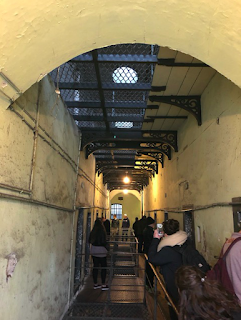 Going to the Wicklow Mountains was an amazing experience. The view was incredible. Even though we were not at the top, you could see so much of the mountain and fully experience its beauty. We learned so much about the history of the mountains as well as the type of land that is at the bottom of the mountains. We were able to see the areas where mining took place as well as the areas untouched which were full of trees. Unfortunately, we did not walk up them because it was very windy, but it was still an unbelievable experience overall, and I would love to revisit it someday.
Going to the Wicklow Mountains was an amazing experience. The view was incredible. Even though we were not at the top, you could see so much of the mountain and fully experience its beauty. We learned so much about the history of the mountains as well as the type of land that is at the bottom of the mountains. We were able to see the areas where mining took place as well as the areas untouched which were full of trees. Unfortunately, we did not walk up them because it was very windy, but it was still an unbelievable experience overall, and I would love to revisit it someday.
River at the base of the mountains
One of our stops on the Wicklow tour was Glendalough. This is a monastery that existed when Vikings still inhabited parts of Ireland. We learned about the history of the monastery, especially about the circular towers which were built in order to hide the belongings of the monks when Vikings raided and pillaged them. We heard many interesting facts similar to this one about the monks and how they lived. Soon after, we walked to the Upper Lake where there was an incredible view. This was located at a lake between two large hills where there was water rushing down the sides of the hills into the lake. This place was so peaceful and tranquil. It was a place where you could easily connect with your surroundings and with nature. This place makes you forget all the stress and problems that occur in your life, and it makes you focus on the beauty around you. This was a remarkable experience and a great start to this day.
On our way home, we stopped to stand on the bogs to see how springy and wet they are. It was incredibly windy, but very cool to see.
- Matt DeFao
Today, after the beautiful Wicklow tour, we visited Kilmainham Gaol, a drastic change from the striking landscape of Glendalough. The building of the Kilmainham Goal itself is an imposing gray structure, with limestone interior walls and a cold stone exterior. The building reminded me of a medieval era castle, due to the high walls and the parapets topping each tall boundary. We first visited a room in the middle of the gaol, with a large alter at the back. This alter was the location of the first and only wedding in the history of the gaol, which was the marriage of Joseph Plunkett and Grace Gifford. This marriage was due to Joseph’s last wish, which was to be married. Joseph was executed the following morning, and he is one of 13 other men to be executed in the gaol.
Cell hallway with grates in ceiling and floor
Hallway of cells
Panopticon
After seeing these cell areas, we saw the exercise yard for the prisoners, who had a very strict schedule including time outside. Interestingly enough, there was also a children’s exercise yard. This was because children at this time were tried the same as adults, so as many as 500 children went through the gaol, including the youngest ever, who was five years old. Many children were in Kilmainham because of the famine in Ireland, due to many families stealing to survive each day. Also due to the famine, from 1845 to 1849 the gaol was extremely overcrowded. There was a Vagrancy Act that was enforced during this time period that made it illegal to beg for money or food, which was part of the cause of the overcrowding of Kilmainham. After the exercise yard, we saw the Stone Breakers Yard, which was the location of the fourteen executions. Thirteen of the fourteen executions were by firing squad, all at the same time. The fourteenth execution was the death of James Connolly, who was the only one executed who was not actually incarcerated at the gaol at the time of the execution. His execution was at a different location in the Yard. Overall, the trip to the gaol was very enlightening, and it was extremely interesting to hear all about the history of the gaol, and especially how the gaol played a part in the history of Easter Rising and the fight for freedom by the Irish.
Stone breaker’s yard Mural painted on wall of jail cell of Grace Gifford
- Chris Kenney













Comments
Post a Comment